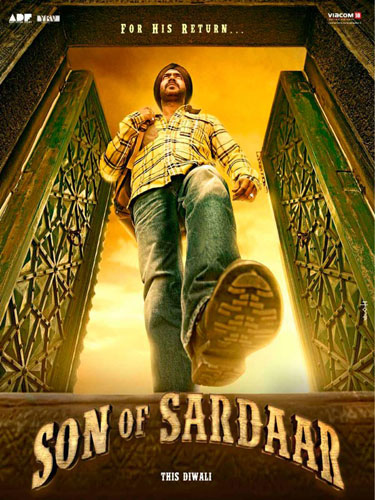
After bringing out VFX for Ranbir Kapoor starrer BARFI! , Pixion, one of the leading studios known for delivering quality VFX, has recently executed 3800 VFX Shots for Ajay Devgn and Sonakshi Sinha starrer ‘Son of Sardar’.
At Pixion, the VFX for Son of Sardar was carried out with the contribution of Viral Thakkar, the VFX Head, Naveen Paul as the VFX Supervisor, Sudhir Trivedi, who played the role of the CG Supervisor and Pankaj Kalbende, has been the Associate VFX Supervisor for the movie.
The shooting for the movie commenced in the month of November’11.Pixion received the final edit of the movie by the first week of this year’s January and proceeded VFX work on the movie.
Maximum part of Son of Sardar was shot in Punjab and the shooting of the movie was completed in 80 days time. Around 110 artists have worked for 6 months on the VFX for the movie and the final VFX shot for the movie on the 25th Oct ’12.
Visual effects tools including, clean-ups, set-extensions, multiple plate-composites were brought into picture to set the look of the movie. Ashwani Dheer, the Director of Son of Sardar briefed Pixion on the kind of VFX expectation he had for the movie. In the brief given by Ashwani, he suggested Pixion to execute actions which looked huge and appealing with chunks of footage shot live and also against chroma backgrounds.
Coming to the bundle of VFX sequences in the movie, the Horse sequence, according to Pixion, was a challenging task. In the horse sequence, we see numerous amounts of facial expressions on the horse’s face and working on these expressions was a bit tricky for Pixion. It has taken around 3 weeks for a team for of 10 artists to deliver this shot.
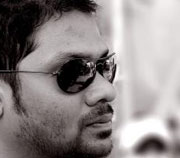 Speaking to Animationxpress.com’s Zeenia Boatwala about the prime highlights of the VFX in this movie, Naveen Paul, VFX Supervisor of Son of Sardar, shares, “The horse was entirely modeled and made up using CG, with most of the film being shot in Punjab; the shooting schedule was spread across eighty days, and with this it was requisite that we design the shots swiftly.”
Speaking to Animationxpress.com’s Zeenia Boatwala about the prime highlights of the VFX in this movie, Naveen Paul, VFX Supervisor of Son of Sardar, shares, “The horse was entirely modeled and made up using CG, with most of the film being shot in Punjab; the shooting schedule was spread across eighty days, and with this it was requisite that we design the shots swiftly.”
To achieve the facial animation for the horse, the animators studied various references and videos of horse movements and created animatics to understand the expression flow of the horse.
Highlighting more on the making of this shot, Sudhir Trivedi, CGI Supervisor of Son of Sardar says, “ Creating Fur for the horse was a bit challenging, but we managed to complete it around 15 days time. We tracked all the movements of the horse face in around 6 shots. With every shot planned, we would discuss and evaluate how a particular shot or scene should be treated and executed.
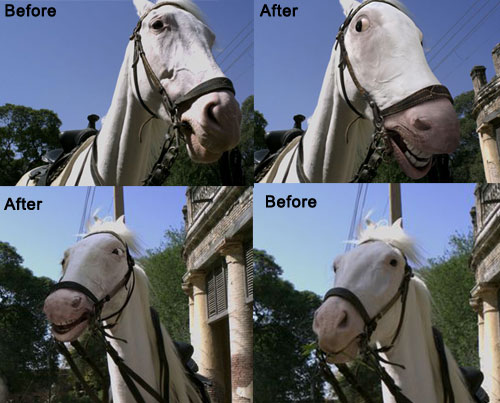
The director was very clear with what he wanted. Ajay Devgn was also involved heavily with the making of this movie, so we all together discussed on the further course of action that was needed.”
The next is the Turban Shot in which the Turban was shown tied all by itself to the forehead of Ajay Devgn. In the brief given to the CGI Team, Naveen Paul told the team to study cloth behavior, for which the team sorted out various cloth video references to understand the motion, timing and look and feel of the cloth.
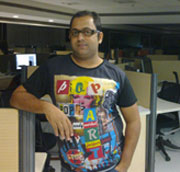 Sudhir adds, “Once we had an idea of the cloth movement, timing and material flow, we started our research and development, where CG cloth simulation, look and feel was finalized .Our artist have done great job in getting the exact cloth simulation in CG. Once the R and D was completed we proceeded with modeling, texturing, shading and lighting to match real look and feel for each shots.
Sudhir adds, “Once we had an idea of the cloth movement, timing and material flow, we started our research and development, where CG cloth simulation, look and feel was finalized .Our artist have done great job in getting the exact cloth simulation in CG. Once the R and D was completed we proceeded with modeling, texturing, shading and lighting to match real look and feel for each shots.
A total of 3 weeks has been taken to complete the Turban sequence with over 10 artists working on it and the sequence was divided into 18 shots. Also, the original turban, which Ajay Devgn was wearing in the movie, was brought to Pixion so that the team could understand the kind of material from which the Turban was created. Making most of this opportunity, the team captured snaps of the turban and applied the texture to the CGI Turban.
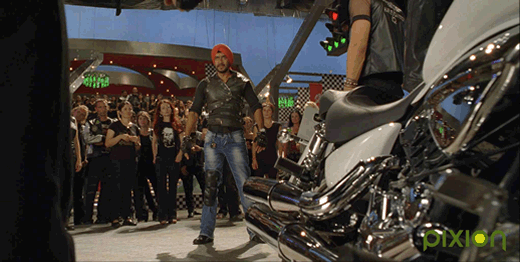
According to Naveen Paul, the challenging and tricky VFX scene in the movie was, Ajay Devgn standing on top of London’s iconic Big-Ben. Also, he mentions that the London Song Sequence was shot at Mehboob Studios in Mumbai in which the entire sequence was shot against a chroma background and was further used to re-create a new city behind the characters.
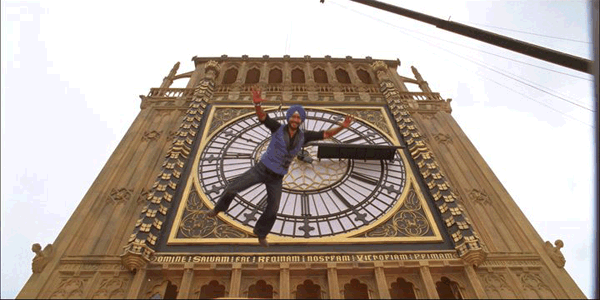
Naveen informs more, “The actions of the characters in the film imbibe a comical vibe clubbed with dangerous stunts, the whole visual effects vision was to basically execute it using this theme in mind. The opening song of the film was shot with a lot of camera movements; some shots of the sequence were match-moved and tracked accordingly. With some camera shots the tracking process was difficult. Depending on the camera movements in the shots, the background was designed as an integral part of the song; we recreated the London’s night skyline and replaced the chroma backgrounds with it.”
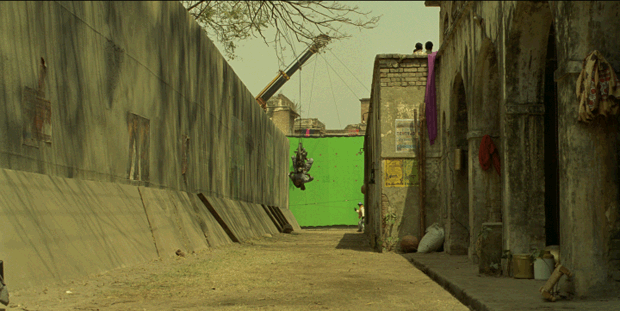
Another noted and challenging shot for the Pixion Team was the Prologue Shot, which took around 10 days to complete. The Director wanted Pixion to give a proper depth in the overall scene. Apart from the characters in this shot, each element was digitally created starting from the background layer, blood squirts, the cornfield, a sickle and wooden Axe. The sequence was shot at a fast speed and hence the compositors had to stitch together various plates of the actors shots and then forward to the CGI team. Initially wind was to be used in the prologue shot, but it was then struck out.
Informing more, Sudhir, states, “The animators carefully matched the motion of the CG elements to the actors. Even the cornfield was simulated; to give the effect of heavy wind flowing throughout the sequence .Well the end result was a very good story telling Prologue sequence which made it later an important part of the film.”
A requisite camera data format was used to shoot the movie. The movie was shot with various cameras by which the data was stored in various formats. Also the use of Go-Pro Cameras was brought into execution.
Naveen adds further, “If a particular scene needs to be shot in a certain way to augment the narrative of the story, we would shoot using the requisite camera data format. So there would be no hindrances or limitations with the visual effects process, with the possibilities of using the various film formats at hand, it made the process easier to work on.”
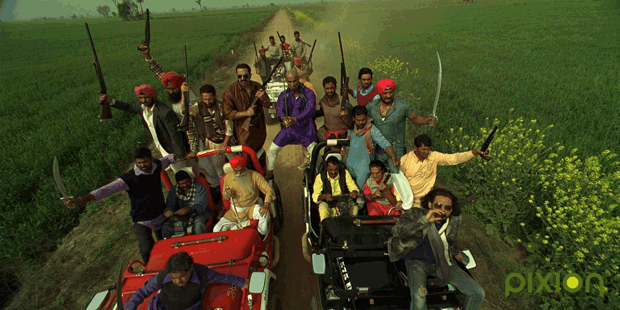
One more highlighted VFX sequence of the movie is the Tornado sequence, in which CGI Tornado and Debris were to be created. Pixion had received reference clips from the director for planning this sequence and has created the sequence in 20 days, which is composed with 7 shots.
Sudhir speaks more, “The Director wanted a natural look, but also needed a proper balance between the environment and the characters. Mainly keeping the characters visible and also showing the dust together seemed tricky and also rendering was a prime challenge, but every aspect was accomplished nicely!”
All the plates of Son of Sardar were shot using 500FPS and sequences to be shot with speeding up and slowing down movements was made possible using a Phantom Camera.
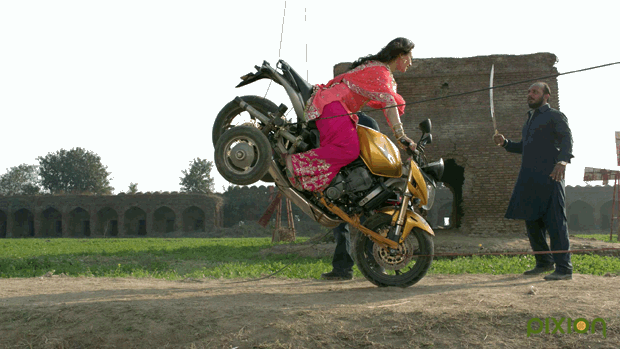
Naveen asserts, “In the climatic sequence, we shot all the plates using 500 frames per second (FPS) separately and Ajay Devgn’s live action plate was ramped to match up to 24 frames per second. The challenge in this shot was to make it look as if the goons were actually being hit by Ajay, even though all the actors were shot separately.
In order to get the look and feel of the shot right, we choreographed and rehearsed the scene thoroughly, with this every movement of the character was planned for camera layout purposes. Reference points were placed on seven sticks in place of the goons, these points ensured correct framing of the actor’s swinging hand movement. There were no CG characters made to augment the scene, we accomplished this shot in ten days. In the online process, a ‘camera shake’ effect was added to accentuate the impact effect visible on screen.”

